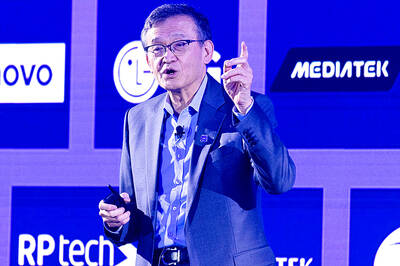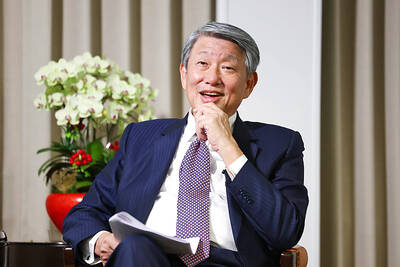HTC Corp (宏達電) is aiming to grab a 20 percent share of China’s high-end market with its introduction of two flagship smartphones, company chairwoman Cher Wang (王雪紅) said.
“It shouldn’t be a problem,” Wang said, referring to the 20 percent goal, in an interview that was published on Tuesday on the Chinese news site Sina.
Wang did not give a timeframe, but said she was confident of reaching the target mainly because of HTC’s “double flagship” strategy in China.
The company is seeking to improve its brand image among customers in China with sales of its HTC One and HTC Butterfly series of smartphones, she said.
TOP-OF-THE-LINE
Although the two smartphone series are classified as HTC’s top-of-the-line products, they are aimed at different market segments and should help boost HTC’s business in China, Wang said.
The Taoyuan-based company saw its smartphone market share in China decline from 8 percent in the first quarter of last year to 7.1 percent in the second quarter of this year, according to an Aug. 16 report by Avanti, a division of the research company TrendForce.
However, HTC’s brand awareness among Chinese consumers improved from 23 percent to 28.4 percent during that period, trailing behind only Apple Inc (80.6 percent) and Samsung Electronics Co (79.6 percent), the report said.
Some analysts expect HTC to be hurt by Microsoft Corp’s recent acquisition of Finnish phone vendor Nokia Oyj’s handset business, but Wang said the partnership between HTC and Microsoft on Windows phones remains intact.
“We have always maintained a good relationship with Microsoft and we were the first company to be informed of the deal,” she said. “From Microsoft’s perspective, they are hoping HTC will continue working with them. Let’s wait and see how the cooperation develops.”
Asked about a Wall Street Journal report that HTC is developing a mobile-software system for Chinese consumers, Wang said the company “has no such plans at the moment.”
SHORT ON MINI?
In related news, HTC declined to comment yesterday on a report that the company is facing a shortage of the downsized version of its HTC One flagship device.
The shortage of the HTC One mini, a 4.3-inch smartphone launched two months ago, was due in part to “a casing shortage arising from design difficulties,” Reuters reported on Tuesday, citing an anonymous source.
That has left HTC unable to meet consumer and telecom operator demand for the phone, another source told Reuters, increasing the possibility that the company could post its first net loss in the current quarter.
In an e-mail reply to CNA, HTC said: “We don’t comment on rumors or speculations.”
Calls to Taiwanese smartphone distributors yesterday morning found that the HTC One mini was available on the spot, but it was not clear if there were shortages in overseas markets.
Many market analysts believe HTC will fail to reach its third-quarter sales target of NT$50 billion (US$1.69 billion) to NT$60 billion, as the company continues its efforts to clear inventories of old stocks.
HTC shares closed down 3.57 percent at NT$135 yesterday. The stock has lost nearly 90 percent of its value since its peak in April 2011.

Nvidia Corp CEO Jensen Huang (黃仁勳) today announced that his company has selected "Beitou Shilin" in Taipei for its new Taiwan office, called Nvidia Constellation, putting an end to months of speculation. Industry sources have said that the tech giant has been eyeing the Beitou Shilin Science Park as the site of its new overseas headquarters, and speculated that the new headquarters would be built on two plots of land designated as "T17" and "T18," which span 3.89 hectares in the park. "I think it's time for us to reveal one of the largest products we've ever built," Huang said near the

China yesterday announced anti-dumping duties as high as 74.9 percent on imports of polyoxymethylene (POM) copolymers, a type of engineering plastic, from Taiwan, the US, the EU and Japan. The Chinese Ministry of Commerce’s findings conclude a probe launched in May last year, shortly after the US sharply increased tariffs on Chinese electric vehicles, computer chips and other imports. POM copolymers can partially replace metals such as copper and zinc, and have various applications, including in auto parts, electronics and medical equipment, the Chinese ministry has said. In January, it said initial investigations had determined that dumping was taking place, and implemented preliminary

Intel Corp yesterday reinforced its determination to strengthen its partnerships with Taiwan’s ecosystem partners including original-electronic-manufacturing (OEM) companies such as Hon Hai Precision Industry Co (鴻海精密) and chipmaker United Microelectronics Corp (UMC, 聯電). “Tonight marks a new beginning. We renew our new partnership with Taiwan ecosystem,” Intel new chief executive officer Tan Lip-bu (陳立武) said at a dinner with representatives from the company’s local partners, celebrating the 40th anniversary of the US chip giant’s presence in Taiwan. Tan took the reins at Intel six weeks ago aiming to reform the chipmaker and revive its past glory. This is the first time Tan

CUSTOMERS’ BURDEN: TSMC already has operations in the US and is a foundry, so any tariff increase would mostly affect US customers, not the company, the minister said Taiwanese manufacturers are “not afraid” of US tariffs, but are concerned about being affected more heavily than regional economic competitors Japan and South Korea, Minister of Economic Affairs J.W. Kuo (郭智輝) said. “Taiwan has many advantages that other countries do not have, the most notable of which is its semiconductor ecosystem,” Kuo said. The US “must rely on Taiwan” to boost its microchip manufacturing capacities, Kuo said in an interview ahead of his one-year anniversary in office tomorrow. Taiwan has submitted a position paper under Section 232 of the US Trade Expansion Act to explain the “complementary relationship” between Taiwan and the US